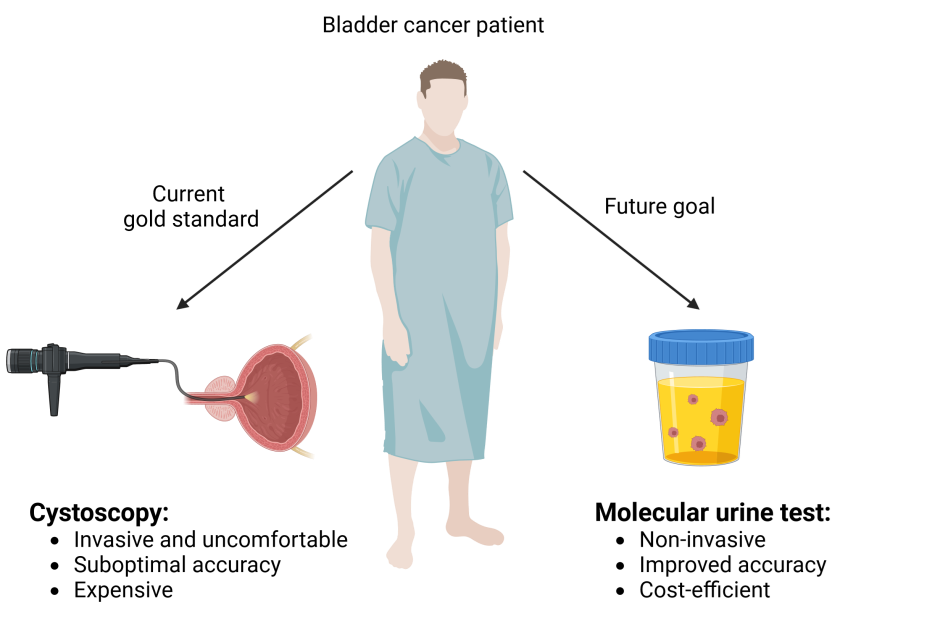Bladder cancer
Background
Bladder cancer affects close to 600,000 people yearly, causes over 200,000 deaths [1], and is one of the most expensive cancer types to manage [2]. Yet, bladder cancer research is underrepresented, underfunded, and has consequently been referred to as the “Cinderella” of cancers [3] or the “forgotten cancer” [4].
The most common bladder cancer symptom is gross hematuria, i.e. visible blood in the urine, which is present in almost 80% of newly diagnosed patients [5]. However, hematuria may also be caused by a variety of other genitourinary conditions, and the incidence of bladder cancer among hematuria patients is less than 20% [6].
About 70-75% of bladder cancer patients are diagnosed with non-muscle-invasive bladder cancer (NMIBC), and have up to 78% risk of recurrence after curative treatment [7, 8]. Moreover, around 20% with high risk disease will progress in stage [7]. The high recurrence and progression rates necessitate frequent patient surveillance.
The gold standard for both detection and surveillance of bladder cancer is cystoscopy. Cystoscopy is invasive, costly and has imperfect diagnostic accuracy, with only 71% sensitivity and 72% specificity reported in a meta-analysis [9]. Consequently, an accurate, cost-efficient and non-invasive test for detection of bladder cancer is warranted (Figure 1). A handful of urine tests have FDA-approval, and a variety of molecular biomarker tests have been suggested in the literature [10], but none are routinely used in the clinic.

Figure 1: A non-invasive, accurate and cost-efficient urine test for bladder cancer detection and surveillance that can replace or reduce the use of cystoscopy is warranted. Figure created with BioRender.com.
Research
We have developed a urine-based biomarker test (BladMetrix) consisting of DNA methylation markers for managing bladder cancer. BladMetrix has shown promising results both for detecting cancer among patients with hematuria (Pharo et al., Clin Epigenetics, 2022), and for monitoring cancer recurrence (Vedeld et al., Mol Oncol, 2024, in press). Currently, BladMetrix is being clinically validated in a monitoring trial. Patient inclusion was completed in December 2023 (n=600 patients), and all patients will be followed for two years with the urine test simultaneously as standard cystoscopy controls.
Innovation
The BladMetrix test is protected by two patent applications. One granted US (US9797016) and EP (2,630,261) and one pending (WO/2020/099938). BladMetrix has also attracted commercial interest.
Relevant publications
BladMetrix: a novel urine DNA methylation test with high accuracy for detection of bladder cancer in hematuria patients. Clin Epigenetics, 14 (1), 115
PubMed 36115961
TCF21 and PCDH17 methylation: An innovative panel of biomarkers for a simultaneous detection of urological cancers Epigenetics, 6 (9), 1120-30
PubMed 21847011
Three epigenetic biomarkers, GDF15, TMEFF2, and VIM, accurately predict bladder cancer from DNA-based analyses of urine samples Clin Cancer Res, 16 (23), 5842-51
PubMed 20975101
References
[1] GLOBOCAN. Global Cancer Statistics 2020 [Online]. Available: http://gco.iarc.fr/
[2] K. D. Sievert, B. Amend, U. Nagele, D. Schilling, J. Bedke, M. Horstmann, et al., "Economic aspects of bladder cancer: what are the benefits and costs?," World J Urol, vol. 27, pp. 295-300, Jun 2009.
[3] R. A. Huddart, R. Jones, and A. Choudhury, "A New Dawn for Bladder Cancer? Recommendations from the National Institute for Health and Care Excellence (NICE) on Managing Bladder Cancer," Clin Oncol (R Coll Radiol), vol. 27, pp. 380-1, Jul 2015.
[4] E. A. o. Urology. (2022, 13. december). Bladder Cancer: The Forgotten Cancer. Available: https://uroweb.org/news/bladder-cancer-the-forgotten-cancer
[5] D. Ramirez, A. Gupta, D. Canter, B. Harrow, R. W. Dobbs, V. Kucherov, et al., "Microscopic haematuria at time of diagnosis is associated with lower disease stage in patients with newly diagnosed bladder cancer," BJU Int, vol. 117, pp. 783-6, May 2016.
[6] B. P. Rai, J. Luis Dominguez Escrig, L. Vale, T. Kuusk, O. Capoun, V. Soukup, et al., "Systematic Review of the Incidence of and Risk Factors for Urothelial Cancers and Renal Cell Carcinoma Among Patients with Haematuria," Eur Urol, vol. 82, pp. 182-192, Aug 2022.
[7] A. T. Lenis, P. M. Lec, K. Chamie, and M. D. Mshs, "Bladder Cancer: A Review," Jama, vol. 324, pp. 1980-1991, Nov 17 2020.
[8] S. van den Bosch and J. Alfred Witjes, "Long-term cancer-specific survival in patients with high-risk, non-muscle-invasive bladder cancer and tumour progression: a systematic review," Eur Urol, vol. 60, pp. 493-500, Sep 2011.
[9] G. Mowatt, J. N'Dow, L. Vale, G. Nabi, C. Boachie, J. A. Cook, et al., "Photodynamic diagnosis of bladder cancer compared with white light cystoscopy: Systematic review and meta-analysis," Int J Technol Assess Health Care, vol. 27, pp. 3-10, Jan 2011.
[10] E. Laukhtina, S. R. Shim, K. Mori, D. D'Andrea, F. Soria, P. Rajwa, et al., "Diagnostic Accuracy of Novel Urinary Biomarker Tests in Non-muscle-invasive Bladder Cancer: A Systematic Review and Network Meta-analysis," Eur Urol Oncol, Nov 6 2021.